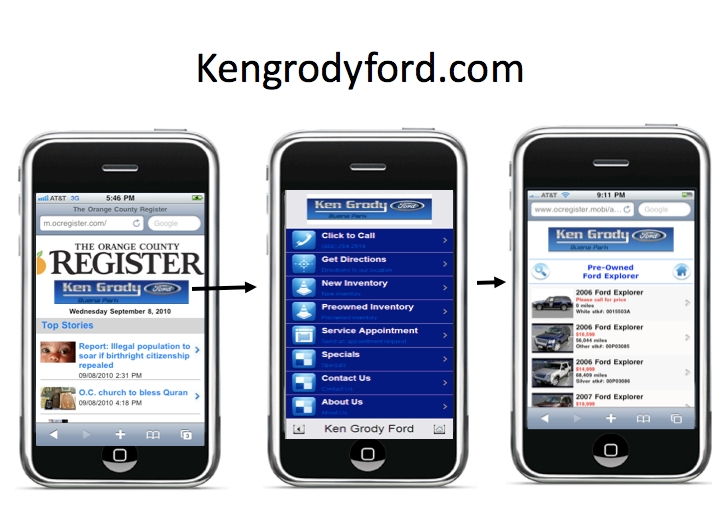Freedom Interactive: Borrell's 2010 Best of the Best in Mobile Strategy
Company: Freedom Interactive, owners of 41 daily newspaper; 8 broadcast and 19 varsity sports sites throughout the United States
Key Executive: Douglas Bennett, President
Summary: In 2010, Freedom Interactive was chosen by Borrell & Associates as one of the "best of the best" newspaper adoptions of mobile technology. But this was not always the case. Doug Bennett, president of Freedom Interactive, says that two years ago Freedom was "in the back of the pack" of newspapers developing digital and mobile products. The sharp decline in revenues in 2008 motivated the company to be more aggressive. This case study outlines their plan and results so far.
Challenge: Heading into the swift transition from computers to mobile devices, Freedom Interactive was chosen recently by Borrell as one of the "best of the best" newspaper adoptions of mobile technology. But this was not always the case. Doug Bennett, president of Freedom Interactive, says that two years ago Freedom was "in the back of the pack" of newspapers developing digital and mobile products. The sharp decline in revenues in 2008 motivated the company to be more aggressive.
Strategy: Mobile is an integral part of the company's move into digital services. "Mobile is not something we should think of as an incremental opportunity. Before our brands were positioned to be all things to all people," says Douglas Bennett, President. But mobile services requires splitting aggregated news into different products for readers with specific interests.
Freedom Interactive's mobile initiatives began by defining criteria for winning and adopting the following tenets:
1. Treat mobile as a unique channel. Mobile has its own characteristics, including the need for audience-specific products. "You want to get informtion parsed the way they want it. So many people now want only sports or only traffic or only weather."
2. Understand the nature of short-lived products and the need for quick to market solutions. Bennett is unconcerned about the advent of HTML5 which seems destined to replace the major share of app usage. "Apps are disposable... you are going to change apps and they may only have a 30 day life span."
3. Leverage the advantages of the mobile platform, such as click to call or sign up.
4. Develop niche products that help people make local, ongoing or seasonal decisions.
The team decided to take the development of mobile sites in-house, while expanding texting programs for breaking news, sports and classifieds. The revenue streams come from sponsorships of text programs and apps, in addition to display ads.
In total, there are over 50 new mobile sites built in house and approximately 75 mobile apps for smart phones build with a third party developer including:
• 22 news
• 6 varsity
• 16 each for auto, real estate and directory platforms
• 6 events
• 6 deals
• 22 iPad
To promote the app launch in Orange County, the team secured a sponsorship with Honda to give away a car (see case study here). They also developed an app for another large auto dealer to help that customer promote its own business on mobile.
Overall Results: So far, Bennett says the mobile initiative has been successful and Freedom Interactive is on track to replace declines of 5 to 6% in print revenues with increases of 18 to 25% in digital revenues.
Mobile WaP growth has been 125% year over year, and now mobile traffic accounts for 9% of all Internet traffic to media properties.
Engagement is also up on the sites; 10 pages per unique visitor per month on the Web, 6 pages per unique visitor per month on the WAP and an astounding 30 pages per unique visitor per month on apps. The app strategy also has high retention, about 70% of users continue using the apps so far.
In revenues, all of the apps have been sold with sponsorships. Revenues are still between 30% from display, 60% from texting alerts and 10% from other sources.
Lessons learned:
Like an increasing number of organizations going transitioning to a new business model, Bennett's background is outside the media industry. He sees his role as lead evangelist as well as a strategist. "My role is to evangelize the changes each and every day...corral the cats around these changes, recognizing that we still have print that keeps the lights on."
The role of the CEO in backing up new initiatives is also critical. Otherwise, he says, "The DNA of the traditional culture will drive you out. If the CEO is unwilling to protectthe innovation, then ultimately it is not going to work."
Rank and file management must be prepared to change, or "you may have to hire."
"Two years ago we were behind and we finally had the decline in revenue that caused everybody to change," Bennett says. Business conditions actually helped, "if busines was static I couldn't have moved as fast."

The author, Alisa Cromer is publisher of a variety of online media, including LocalMediaInsider and MediaExecsTech, developed while on a fellowship with the Reynolds Journalism Institute and which has evolved into a leading marketing company for media technology start-ups. In 2017 she founded Worldstir.com, an online magazine, to showcases perspectives from around the world on new topic each month, translated from and to the top five languages in the world.






